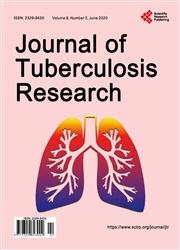Evaluation of Antibacterial Activities and Cytotoxicity of Three Medicinal Plants Used for the Management of Mycobacterium tuberculosis and Staphylococcus aureus Infections in the North-West Region of Cameroon
引用次数: 2
Abstract
Introduction: Chemotherapy is used to combat tuberculosis, and other microbial infections. Unfortunately, resistance has been reported to a vast majority of currently use drugs. The objective of this study was to search for new therapies from plant products for the sustainable management of tuberculosis and S. aureus infections. Materials and Methods: Crude extracts were obtained by sequential maceration of dry powdered plant material in three solvents; hexane, dichloromethane and methanol. Phytochemical screening to identify active constituents in the crude extracts was done by conventional methods. The antimycobacterial and antimicrobial activity on M. tuberculosis control strain H37Ra and a clinical isolate of S. aureus respectively, was evaluated at eight different concentrations using the microplatealamar blue assay. Cytotoxicity of the active extracts was evaluated on monkey kidney epithelial cells and assessed using the MTT/formazan assay. Results: Twelve crude extracts were obtained, the hexane extract of Sanseviera liberica rhizomes (P3rH) showed antimycobacterial activity with a minimum inhibitory concentration (MIC) of 1 mg/mL. The hexane and methanol extracts of Emilia coccinea, P2H and P2M respectively, showed antimicrobial activity with MICs of 500 μg/mL and 1000 μg/mL respectively. P2M and P2H had selectivity indices of respectively, 0.1046 and 0.2336. Conclusion: This study validates the use of S. liberica and E. coccinea for the traditional management of tuberculosis and S. aureus infections, respectively. Furthermore, it provides a base for the purification of the active extracts and generation of leads in the search of alternative drugs for the management of these microbial infections.喀麦隆西北地区用于治疗结核分枝杆菌和金黄色葡萄球菌感染的三种药用植物的抗菌活性和细胞毒性评估
简介:化疗用于对抗结核病和其他微生物感染。不幸的是,目前使用的绝大多数药物都有耐药性报告。本研究的目的是从植物产品中寻找新的治疗方法,用于结核病和金黄色葡萄球菌感染的可持续管理。材料和方法:将干燥的植物粉末材料在三种溶剂中依次浸渍,得到粗提物;己烷、二氯甲烷和甲醇。采用常规方法进行植物化学筛选,以鉴定粗提物中的活性成分。使用微板蓝测定法在八种不同浓度下分别评估了对结核分枝杆菌对照菌株H37Ra和金黄色葡萄球菌临床分离株的抗分枝杆菌和抗微生物活性。活性提取物对猴肾上皮细胞的细胞毒性进行评估,并使用MTT/甲zan测定法进行评估。结果:获得12个粗提物,自由三叶根状茎正己烷提取物(P3rH)具有抗分枝杆菌活性,最低抑菌浓度(MIC)为1 mg/mL。球虫的己烷和甲醇提取物P2H和P2M分别具有500μg/mL和1000μg/mL的MIC。P2M和P2H的选择性指数分别为0.1046和0.2336。结论:本研究验证了自由球菌和球虫分别用于结核病和金黄色葡萄球菌感染的传统治疗。此外,它为纯化活性提取物和产生线索提供了基础,以寻找治疗这些微生物感染的替代药物。
本文章由计算机程序翻译,如有差异,请以英文原文为准。
求助全文
约1分钟内获得全文
求助全文

 求助内容:
求助内容: 应助结果提醒方式:
应助结果提醒方式:


